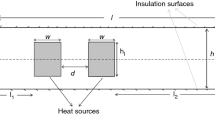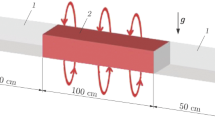Abstract
The present study reports numerical simulations of water-based Al2O3 nanofluid flowing in a 2D channel with a heated wall-mounted obstacle. The conjugated heat transfer problem including forced convection within the fluid and conduction inside the obstacle is numerically solved using the mixture model with temperature-dependent properties. The model has been first carefully validated against published data. Then, the fluid flow and heat transfer have been investigated for six nanoparticle volume fractions \(\varphi\) up to \(1.8\%\) and bulk Reynolds numbers within the range \(100 \le Re \le 1600\). The results show that only the Reynolds number has an influence on the hydrodynamic field, especially on the reattachment length behind the obstacle. The heat transfer rate increases with increasing nanoparticle concentrations and/or Reynolds number. The second law analysis is employed to study the heat transfer and fluid friction irreversibilities. The average entropy generation increases linearly with the Reynolds number. Increasing the nanoparticle volume fraction reduces the thermal entropy generation while the frictional one increases. Finally, the benefit of using this nanofluid is discussed regarding five merit criteria.













Similar content being viewed by others
References
Amirahmadi S, Rashidi S, Esfahani JA. Minimization of exergy losses in a trapezoidal duct with turbulator, roughness and beveled corners. Appl Therm Eng. 2016;107:533–43.
Rashidi S, Akbarzadeh M, Karimi N, Masoodi R. Combined effects of nanofluid and transverse twisted-baffles on the flow structures, heat transfer and irreversibilities inside a square duct-a numerical study. Appl Therm Eng. 2018;130:135–48.
Young TJ, Vafai K. Experimental and numerical investigation of forced convective characteristics of arrays of channel mounted obstacles. Trans ASME J Heat Transf. 1999;121:34–42.
Umur H, Yemenici O, Umur Y, Sakin A. Flow and heat transfer characteristics over rectangular blocked surfaces. Exp Heat Transf. 2017;30(3):192–204.
Young TJ, Vafai K. Convective cooling of a heated obstacle in a channel. Int J Heat Mass Transf. 1998;41(20):3131–48.
Young TJ, Vafai K. Convective flow and heat transfer in a channel containing multiple heated obstacles. Int J Heat Mass Transf. 1998;41(21):3279–98.
Wang Y. Heat transfer and pressure loss characterization in a channel with discrete flush-mounted and protruding heat sources. Exp Heat Transf. 1999;12(1):1–16.
Korichi A, Oufer L. Numerical heat transfer in a rectangular channel with mounted obstacles on upper and lower walls. Int J Therm Sci. 2005;44(7):644–55.
Jang SP, Choi SUS. Effects of various parameters on nanofluid thermal conductivity. J Heat Transf. 2007;129(5):617–23.
Choi SUS, Eastman JA. Enhancing thermal conductivity of fluids with nanoparticles. ASME Publ Fed. 1995;231:99–106.
Xian-Ju W, Xin-Fang L. Influence of pH on nanofluids’ viscosity and thermal conductivity. Chin Phys Lett. 2009;26(5):056601.
Liu M, Ding C, Wang J. Modeling of thermal conductivity of nanofluids considering aggregation and interfacial thermal resistance. RSC Adv. 2016;6(5):3571–7.
Bouguerra N, Poncet S, Elkoun S. Dispersion regimes in alumina/water-based nanofluids: simultaneous measurements of thermal conductivity and dynamic viscosity. Int Commun Heat Mass Transf Correct Proofs. 2018;92:51.
Suresh S, Chandrasekar M, Sekhar SC. Experimental studies on heat transfer and friction factor characteristics of CuO/water nanofluid under turbulent flow in a helically dimpled tube. Exp Thermal Fluid Sci. 2011;35(3):542–9.
Heyhat MM, Kowsary F, Rashidi AM, Momenpour MH, Amrollahi A. Experimental investigation of laminar convective heat transfer and pressure drop of water-based Al2O3 nanofluids in fully developed flow regime. Exp Thermal Fluid Sci. 2013;44:483–9.
Aghaei A, Sheikhzadeh GA, Dastmalchi M, Forozande H. Numerical investigation of turbulent forced-convective heat transfer of Al2O3–water nanofluid with variable properties in tube. Ain Shams Eng J. 2015;6(2):577–85.
Mahdavi M, Sharifpur M, Meyer JP. CFD modelling of heat transfer and pressure drops for nanofluids through vertical tubes in laminar flow by lagrangian and eulerian approaches. Int J Heat Mass Transf. 2015;88:803–13.
Sekrani G, Poncet S. Further investigation on laminar forced convection of nanofluid flows in a uniformly heated pipe using direct numerical simulations. Appl Sci. 2016;6(332):1–24.
Sekrani G, Poncet S, Proulx P. Modeling of convective turbulent heat transfer of water-based Al2O3 nanofluids in an uniformly heated pipe. Chem Eng Sci. 2018;176:205–19.
Heidary H, Kermani MJ. Heat transfer enhancement in a channel with block(s) effect and utilizing nano-fluid. Int J Therm Sci. 2012;57:163–71.
Sidik NAC, Khakbaz M, Jahanshaloo L, Samion S, Darus AN. Simulation of forced convection in a channel with nanofluid by the lattice Boltzmann method. Nanoscale Res Lett. 2013;8(1):178.
Esfe MH, Arani AAA, Niroumand AH, Yan W-M, Karimipour A. Mixed convection heat transfer from surface-mounted block heat sources in a horizontal channel with nanofluids. Int J Heat Mass Transf. 2015;89:783–91.
Khoshvaght-Aliabadi M, Hormozi F. Heat transfer enhancement by using copper-water nanofluid flow inside a pin channel. Exp Heat Transf. 2015;28(5):446–63.
Foroutani S, Rahbari A. Numerical investigation of laminar forced convection heat transfer in rectangular channels with different block geometries using nanofluids. Thermal Sci. 2017;21(5):2129–38.
Togun H. Laminar CuO–water nano-fluid flow and heat transfer in a backward-facing step with and without obstacle. Appl Nanosc. 2016;6(3):371–8.
Bejan A. Second law analysis in heat transfer. Energy. 1980;5(8–9):720–32.
Bejan A. Entropy generation through heat and fluid flow. Hoboken: Wiley; 1982.
Mehrez Z, El Cafsi A, Belghith A, Le Quéré P. MHD effects on heat transfer and entropy generation of nanofluid flow in an open cavity. J Magn Magn Mater. 2015;374:214–24.
Alfaryjat AA, Stanciu D, Dobrovicescu A, Badescu V, Aldhaidhawi M, Numerical investigation of entropy generation in microchannels heat sink with different shapes. In: IOP conference series: materials science and engineering, Vol. 147, IOP Publishing, 2016; p. 012134.
Oztop HF, Al-Salem K. A review on entropy generation in natural and mixed convection heat transfer for energy systems. Renew Sustain Energy Rev. 2012;16(1):911–20.
Mahian O, Kianifar A, Kleinstreuer C, Al-Nimr MA, Pop I, Sahin AZ, Wongwises S. A review of entropy generation in nanofluid flow. Int J Heat Mass Transf. 2013;65:514–32.
Sciacovelli A, Verda V, Sciubba E. Entropy generation analysis as a design tool—a review. Renew Sustain Energy Rev. 2015;43:1167–81.
Boghrati M, Bajestan EE, Etminan V, Entropy generation minimization of confined nanofluids laminar flow around a block. In: ASME 2010 10th biennial conference on engineering systems design and analysis, 2010; Vol. 5.
Sheremet MA, Oztop HF, Pop I, Abu-Hamdeh N. Analysis of entropy generation in natural convection of nanofluid inside a square cavity having hot solid block: Tiwari and Das’ model. Entropy. 2015;18(1):9.
Li P, Xie Y, Zhang D, Xie G. Heat transfer enhancement and entropy generation of nanofluids laminar convection in microchannels with flow control devices. Entropy. 2016;18(4):134.
Rashidi S, Eskandarian M, Mahian O, Poncet S Combination of nanofluid and inserts for heat transfer enhancement—gaps and challenges. J Thermal Anal Calorim Correct Proofs. 2018;1–24. https://doi.org/10.1007/s10973-018-7070-9.
Cess RD, Shaffer EC. Summary of laminar heat transfer between parallel plates with unsymmetrical wall temperatures. J Aerosp Sci. 1959;26(8):538.
Kheirandish Z, Gandjalikhan Nassab SA, Vakilian M. Study of conjugate convection flow and entropy generation in a channel containing a heated obstacle. Casp J Appl Sci Res. 2013;2(3):104–16.
Bahiraei M. A comprehensive review on different numerical approaches for simulation in nanofluids: traditional and novel techniques. J Dispers Sci Technol. 2014;35(7):984–96.
Kakaç S, Pramuanjaroenkij A. Single-phase and two-phase treatments of convective heat transfer enhancement with nanofluids-a state-of-the-art review. Int J Therm Sci. 2016;100:75–97.
Syamlal M, Rogers W, Obrien T. MFIX documentation theory guide. US Department of Energy, Morgantown Energy Technology Center, Morgantown, USA: Tech. rep; 1993.
Vargaftik NB. Tables on the thermophysical properties of liquids and gases. Washington: Hemisphere Pub. Corp; 1975.
de Castro CAN, Li SFY, Nagashima A, Trengove RD, Wakeham WA. Standard reference data for the thermal conductivity of liquids. J Phys Chem Ref Data. 1986;15(3):1073–86.
Chon CH, Kihm KD, Lee SP, Choi SUS. Empirical correlation finding the role of temperature and particle size for nanofluid (Al2O3) thermal conductivity enhancement. Appl Phys Lett. 2005;87(15):3107.
Manninen M, Taivassalo V, Kallio S. On the mixture model for multiphase flow. VTT Publ. 1996;288:1–67.
Schiller L, Naumann Z. A drag coefficient correlation. Vdi Zeitung. 1935;77(318):51.
Wang X, Xu X, Choi SUS. Thermal conductivity of nanoparticle-fluid mixture. J Thermophys Heat Transf. 1999;13(4):474–80.
Wen D, Ding Y. Experimental investigation into convective heat transfer of nanofluids at the entrance region under laminar flow conditions. Int J Heat Mass Transf. 2004;47:5181–8.
Sundar L, Sharma K. Heat transfer enhancements of low volume concentration Al2O3 nanofluid and with longitudinal strip inserts in a circular tube. Int J Heat Mass Transf. 2010;53(19):4280–6.
Behnampour A, Akbari OA, Safaei MR, Ghavami M, Marzban A, Shabani GAS, Mashayekhi R, et al. Analysis of heat transfer and nanofluid fluid flow in microchannels with trapezoidal, rectangular and triangular shaped ribs. Phys E. 2017;91:15–31.
Diaz-Daniel C, Laizet S, Vassilicos JC. Direct numerical simulations of a wall-attached cube immersed in laminar and turbulent boundary layers. Int J Heat Fluid Flow. 2017;68:269–80.
Eslami M, Tavakol MM, Goshtasbirad E. Laminar fluid flow around two wall-mounted cubes of arbitrary configuration. Proc IMechE Part C J Mech Eng Sci. 2010;224:2396–407.
Heris SZ, Esfahany MN, Etemad SG. Experimental investigation of convective heat transfer of Al2O3/water nanofluid in circular tube. Int J Heat Fluid Flow. 2007;28(2):203–10.
Kotas TJ. The exergy analysis method of thermal plant analysis. Malabar: Krieger Publishing Company; 1995.
Aspelund A, Berstad DO, Gundersen T. An extended pinch analysis and design procedure utilizing pressure based exergy for subambient cooling. Appl Therm Eng. 2007;27(16):2633–49.
Bianco V, Manca O, Nardini S. Second law analysis of Al2O3–water nanofluid turbulent forced convection in a circular cross section tube with constant wall temperature. Adv Mech Eng. 2013;5:920278.
Selimefendigil F, Öztop HF. Numerical study of forced convection of nanofluid flow over a backward facing step with a corrugated bottom wall in the presence of different shaped obstacles. Heat Transf Eng. 2016;37(15):1280–92.
Mehrez Z, Bouterra M, El Cafsi A, Belghith A. Heat transfer and entropy generation analysis of nanofluids flow in an open cavity. Comput Fluids. 2013;88:363–73.
Prasher R, Song D, Phelan JW. Measurements of nanofluid viscosity and its implications for thermal applications. Appl Phys Lett. 2006;89:133108.
Simons R. Comparing heat transfer rates of liquid coolants using the Mouromtseff number. Calc Corner. 2006;12(2):10.
Ferrouillat S, Bontemps A, Ribeiro JP, Gruss JA, Soriano O. Hydraulic and heat transfer study of SiO2/water nanofluids in horizontal tubes with imposed wall temperature boundary conditions. Int J Heat Fluid Flow. 2011;32(2):424–39.
Derakhshan MM, Akhavan-Behabadi MA, Mohseni SG. Experiments on mixed convection heat transfer and performance evaluation of MWCNT-oil nanofluid flow in horizontal and vertical microfin tubes. Exp Thermal Fluid Sci. 2015;61:241–8.
Roy G, Gherasim I, Nadeau F, Poitras G, Nguyen CT. Heat transfer performance and hydrodynamic behavior of turbulent nanofluid radial flows. Int J Therm Sci. 2012;58:120–9.
Siavashi M, Jamali M. Heat transfer and entropy generation analysis of turbulent flow of TiO2–water nanofluid inside annuli with different radius ratios using two-phase mixture model. Appl Therm Eng. 2016;100:1149–60.
Acknowledgements
The authors would like to thank the NSERC chair on industrial energy efficiency established at Université de Sherbrooke in 2014 and supported by Hydro-Québec, Natural Resources Canada (CanmetEnergy in Varennes) and Rio Tinto Alcan. Calculations have been done using the supercomputer Mammouth Parallèle 2 of Compute Canada’s network, which is also here gratefully acknowledged.
Author information
Authors and Affiliations
Corresponding author
Rights and permissions
About this article
Cite this article
Sekrani, G., Poncet, S. & Proulx, P. Conjugated heat transfer and entropy generation of Al2O3–water nanofluid flows over a heated wall-mounted obstacle. J Therm Anal Calorim 135, 963–979 (2019). https://doi.org/10.1007/s10973-018-7349-x
Received:
Accepted:
Published:
Issue Date:
DOI: https://doi.org/10.1007/s10973-018-7349-x




